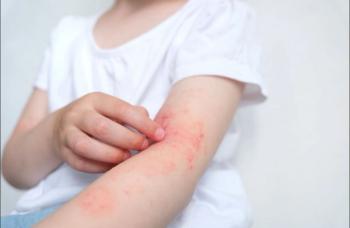
Skin Disorders: 5 Shots, 5 Tips (Series #6)
Here: Dr Rosen presents 5 tips about 5 skin disorders that you might not know.
Case 1
A young adult presents with an asymptomatic but recently changing mole on his arm.
Key point: The white halo surrounding a nevus is pathognomonic for a halo nevus. This likely represents an attack of the body’s own immune system on the melanin-producing cells comprising the lesion (nevus cells).
Treatment: The entire nevus will probably disappear, leaving a white macule which may remain as is or re-pigment over time. No treatment is needed. Excision will probably leave a worse cosmetic outcome than the course of nature.
Note: It was previously thought that the appearance of a halo nevus meant that the original lesion had undergone malignant transformation or that the patient was harboring an occult melanoma elsewhere. However, in the absence of clear symptoms, this is considered a benign phenomenon, and costly melanoma “hunts” are no longer recommended.
Case 2
A young man complains of several tender nodules on the arm and elbow that keep discharging a gritty, white-colored substance.
Key point: The distinct appearance and history are classic for calcinosis cutis-deposition of calcium in the skin. The spicules of calcium erode to the outside, creating the gritty-feeling discharge.
Treatment: The easiest intervention is complete excision, guided by the results of a radiograph. The latter will show the extent of calcium deposition.
Note: There are many reasons for calcinosis cutis, and an appropriate workup is certainly indicated. This would include a search for metabolic derangements (including renal disease), a history of excessive milk ingestion, and signs or symptoms of collagen vascular disease or sarcoidosis. This patient had dermatomyositis.
Case 3
A 28-year-old man complains of an acute onset, intensely pruritic rash on the lower leg. Pertinent history is the recent purchase of a new kitten.
Key point: While it true that not every round rash is ringworm, the latter should be ruled out when presented with an annular, scaly and itchy eruption. In this case, the skin scraping showing innumerable branching hyphae, confirming the clinical suspicion of tinea.
Treatment: Application of an over-the-counter or prescription azole or allylamine antifungal cream, gel or lotion will cure the relatively well-localized eruption.
Note: In an urban setting, the introduction of a young household pet (kitten, puppy) into the living environment is often the root cause of such acute onset dermatophyte infections. The pet must be taken to the veterinarian for diagnosis and treatment.
Case 4
A 27-year-old presents with concerns regarding “red bumps” on his scrotum. He is particularly worried that he has acquired a sexually transmitted disease.
Key point: The bright red, slight scaly 1- to 4-mm papules depicted are typical of the benign condition known as angiokeratoma of Fordyce. They are neither contagious nor premalignant. The lesions are generally asymptomatic, although occasionally may bleed.
Treatment: No treatment is indicated unless bleeding is associated. However, they may be removed with light electrodesiccation or ablation by one of several vascular lasers.
Note: This condition is not to be confused with Fordyce spots, which are small white papules on the shaft of the penis due to ectopic sebaceous glands.
Case 5
A 68-year-old man presents with an extremely painful, secondarily impetiginized ulcer of the scalp. After considerable directed questioning, he admits to picking and gouging the area to “get the space aliens out.”
Key point: This is a factitious, or self-induced, condition. Any bizarre shaped skin lesion should be suspect as being self-induced. There are many reasons which may be underlying: neurosis, psychosis, obsessive-compulsive behavior, delusional states, malingering, potential for monetary gain from favorable litigation, to name a few.
Treatment: Meticulous wound care and administration of appropriate topical or systemic antibiotics would be indicated. Referral to a mental health professional is almost always required to fully assess and address underlying psychopathology.
Note: Although this patient admitted to manipulating the skin and disclosed his delusion, many cases of factitious disease are not so straightforward and require a high index of suspicion to identify.
Newsletter
Enhance your clinical practice with the Patient Care newsletter, offering the latest evidence-based guidelines, diagnostic insights, and treatment strategies for primary care physicians.

















































































































































































































































































